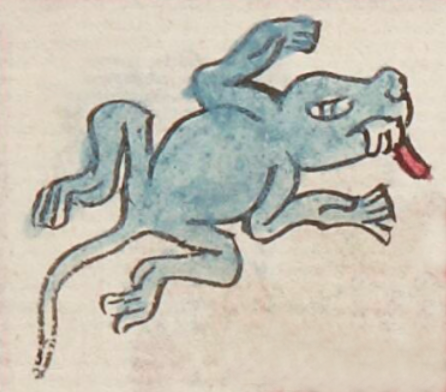cuetzpalin (TR15r)
This simplex glyph of a cuetzpalin (lizard or iguana) involves a day sign in the 260-day divinatory calendar. It has been isolated from a date and shown here in a bird's eye view that also has the head somewhat in profile, looking toward the viewer's right. The animal is a light blue, either turquoise or sky blue, the blue that is used in the Codex Telleriano-Remensis. The animal has a round belly, articulated legs, long toes, and a long tail. Its white teeth are protruding, as is its long red tongue. Its body is at an angle, leaning toward the viewer's right.
Stephanie Wood
Calendrics figured prominently in Nahuas' religious views of the cosmos. Babies were often named for the date in the tonalpohualli, divinatory calendar, they were born.
Stephanie Wood
ca. 1550–1563
Jeff Haskett-Wood
días, days, calendarios, lagartos, iguanas

cuetzpal(in), a lizard, an iguana, https://nahuatl.wired-humanities.org/content/cuetzpalin
el lagarto
Stephanie Wood
Telleriano-Remensis Codex, folio 15 recto, MS Mexicain 385, Gallica digital collection, https://gallica.bnf.fr/ark:/12148/btv1b8458267s/f55.item.zoom
The non-commercial reuse of images from the Bibliothèque nationale de France is free as long as the user is in compliance with the legislation in force and provides the citation: “Source gallica.bnf.fr / Bibliothèque nationale de France” or “Source gallica.bnf.fr / BnF.”

